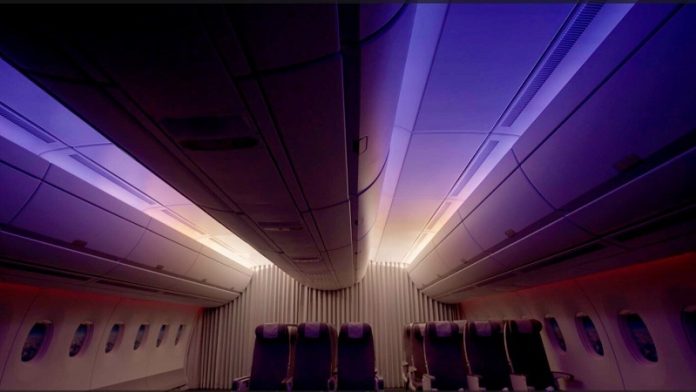
Qantas is introducing a new lighting design for its ultra-long-haul flights, inspired by the Australian landscape and based on circadian science, to help reduce jet lag and improve passenger well-being.
This new approach will be used on Qantas’ upcoming Project Sunrise flights, which will connect Australia’s east coast with London and New York non-stop.
The lighting design, featuring simulations of sunsets and sunrises, is the result of over 150 hours of testing at the Airbus Customer Definition Center in Hamburg.
Representatives from the University of Sydney’s Charles Perkins Center, Qantas, Airbus, and Caon Design Studio collaborated to create and test hundreds of lighting patterns in an Airbus A350 cabin mock-up.
Light is crucial in regulating our body clocks.
By adjusting the timing, strength, and wavelengths of light during a flight, it is possible to help passengers adapt to their destination’s time zone while in the air, thereby reducing jet lag.
Last year, Qantas and the Charles Perkins Center released preliminary findings from research flights that optimized the timing of light, meals, and exercise to combat jet lag. Now, they are taking it a step further by adjusting the color of the light.
“It’s great to see circadian science being translated into practice,” said Associate Professor Sveta Postnova, an expert in circadian modeling at the Charles Perkins Center and the School of Physics. “The new lighting scenarios for the A350 were developed to optimize the circadian effects of light at different times during flights while considering the light’s appearance, ambiance, safety, and hardware requirements on board. It was a true collaborative effort.”
The trial produced 12 unique lighting scenes specifically for the Project Sunrise flights. Some of these include:
- “Awake”: A broad-spectrum blue-enriched lighting to help customers adjust to the destination time zone and stay alert and awake.
- “Sunset”: An immersive transition from daytime mode into dark, moving through sunset colors into a night sky with moonlight and slow cloud effects to relax customers and prepare them for sleep.
- “Sunrise”: Dynamic lighting effective for transitioning from night to day, replicating an Australian sunrise rolling from the front of the cabin to the rear.
The Charles Perkins Center advised on the wavelengths of light that most strongly affect a person’s body clock using melanopic illuminance. This measure tells how light impacts our circadian rhythm. High melanopic illuminance means more light is available to adjust the brain’s central clock. Blue-enriched light with high melanopic illuminance helps shift body clocks, while long-wavelength light (such as red) with low melanopic illuminance helps prevent the clock from shifting undesirably.
Various scenarios were tested and adjusted for eye comfort and appearance during lighting workshops held in Hamburg. Lighting sequences are tailored for each flight to help passengers adjust to destination time zones before they land.
Qantas International CEO Cam Wallace stated that the scientifically informed lighting design is a crucial part of preparing for Project Sunrise flights. “These world-first flights have been an opportunity for us to work with experts and rethink the inflight experience with a focus on customer well-being and combating the effects of jet lag,” said Wallace.
“Combined with cabin design, specialized meal planning, and movement programs, this unique lighting sequence will help improve our customers’ comfort in the air and minimize their jet lag when they arrive at their destination.”
The airline revealed the customized lighting schemes at Airbus’ Airspace Customer Showroom in Toulouse, where a life-size mock-up of the Project Sunrise Well-being Zone is temporarily displayed.


